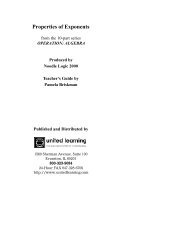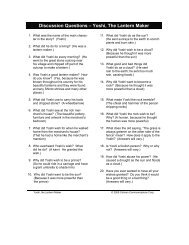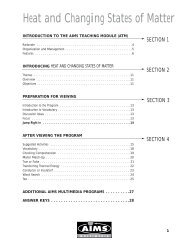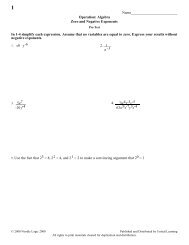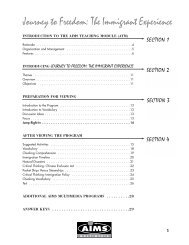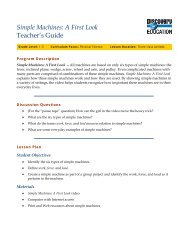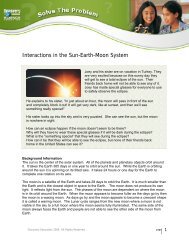Fractional Exponents - Discovery Education
Fractional Exponents - Discovery Education
Fractional Exponents - Discovery Education
Create successful ePaper yourself
Turn your PDF publications into a flip-book with our unique Google optimized e-Paper software.
SD School Pre-Algebra<br />
Program 3: Roots and Rational Numbers<br />
QuikNotes<br />
A cube root like a square root, except the number is<br />
multiplied 3 times to get another whole number. The<br />
cube root of 729 equals 9, because 9 x 9 x 9 = 729.<br />
Student Notes<br />
The 3 in the arm of the radical signals to us that we’re<br />
looking for the cube root.<br />
3<br />
729 = 9<br />
Whenever we have a cube root, or some other odd root,<br />
it’s possible for us to end up with a negative number<br />
under the radical. This is because whenever we multiply<br />
an odd number of negative integers together, our<br />
answer will be negative.<br />
3<br />
−8 =−2 because (−2) × (−2) × (−2) =−8<br />
If there is a negative number under the radical and<br />
we’re looking for an even root, like the square root of<br />
negative 4, it is undefined. The reason we say it’s<br />
undefined is because we can’t find one real number<br />
multiplied by itself to equal negative 16.<br />
This is different than when we have a negative sign in<br />
front of our radical. Remember that this means we’re<br />
looking for the negative of the square root of a number,<br />
which we can do for any number. So, here the negative<br />
square root of 16 is -4.<br />
− 16 =−4<br />
−16 is undefined<br />
Raising a number to the fourth power means<br />
multiplying that number four times. So, the fourth root<br />
of a number means finding the number that when<br />
multiplied 4 times gives us our original number.<br />
For example:<br />
4<br />
16 = 2 because 2 × 2 ×2 × 2 = 16<br />
When we’ve got a number with an exponent that’s a<br />
simple fraction, like 3 to the one-half power, it just<br />
means the square root of 3. We look at what number is<br />
in the denominator and take that root of our base<br />
number.<br />
1<br />
3 2<br />
= 3
SD School Pre-Algebra<br />
Program 3: Roots and Rational Numbers<br />
QuikNotes<br />
If the same kind of exponent is negative, take the<br />
reciprocal of the base number, and then make the<br />
exponent positive.<br />
a<br />
1<br />
−<br />
n<br />
=<br />
a<br />
1<br />
1<br />
n<br />
=<br />
n<br />
1<br />
a<br />
Student Notes<br />
1<br />
− 1 1 1<br />
3<br />
8 = = =<br />
1 3<br />
8 2<br />
3<br />
8<br />
When given a fractional exponent where the numerator<br />
is not a 1:<br />
1. Raise the base number to the power of the<br />
numerator.<br />
2. Take the root as signaled by the denominator.<br />
3<br />
5<br />
4 = 4 3<br />
5 4 3 5 5<br />
= 64 = 2 2<br />
Irrational numbers are decimals that go on forever and<br />
don’t repeat. An example would be the number pi (ð).<br />
A repeating decimal is a rational number. An example<br />
is the fraction, 1/3. It is equal to 0.3333333…<br />
The repetition of 3 goes on forever.<br />
A terminating decimal is also a rational number.<br />
Rational, irrational, and repeating decimals are all real<br />
numbers.<br />
An inequality is a mathematical expression that is<br />
unbalanced. Statements like 5 is greater than 3, or 4 is<br />
less then 7 are considered inequalities because the two<br />
sides don’t balance.<br />
5 > 3 4 < 7
SD School Pre-Algebra<br />
Program 3: Roots and Rational Numbers<br />
QuikCheck<br />
True or False<br />
3 3<br />
1. −8 =− 8 __________<br />
2. − 16 = −16 __________<br />
3. An exponent that’s a simple fraction means the number in the numerator is the root of our<br />
base number. _____________<br />
4. If a fractional exponent is negative, take the reciprocal of the base number and then make<br />
the exponent positive. ________<br />
5. Irrational numbers are decimals that go on forever and don’t repeat. ________<br />
6. An inequality is a mathematical expression that when both sides are multiplied by zero,<br />
yields zero on one side and an irrational number on the other. __________<br />
Problem Solving<br />
3<br />
7. 216<br />
=<br />
1<br />
10. 81 2<br />
=<br />
4<br />
2<br />
13. 9<br />
3<br />
8. −64<br />
=<br />
11. 36 −1 2<br />
=<br />
0<br />
14. 7<br />
3<br />
4<br />
9. 81<br />
=<br />
2<br />
12. 8 3<br />
=<br />
2<br />
3<br />
15. −27
SD School Pre-Algebra<br />
Program 3: Roots and Rational Numbers<br />
QuikCheck Answer Key<br />
True or False<br />
3 3<br />
1. −8 =− 8 True<br />
2. − 16 = −16 False − 16 =−4 ; −16 is undefined.<br />
3. An exponent that’s a simple fraction means the number in the numerator is the root of our<br />
base number. False An exponent that’s a simple fraction means the number in the<br />
denominator is the root of our base number.<br />
4. If a fractional exponent is negative, take the reciprocal of the base number and then make<br />
the exponent positive. True<br />
5. Irrational numbers are decimals that go on forever and don’t repeat. True<br />
6. An inequality is a mathematical expression that when both sides are multiplied by zero,<br />
yields zero on one side and an irrational number on the other. False An inequality is a<br />
mathematical expression that is unbalanced.<br />
Problem Solving<br />
3<br />
7. 216<br />
3<br />
=<br />
216 = 6<br />
6 × 6× 6 = 216<br />
3<br />
8. −64 =<br />
3<br />
−64 =−4<br />
−4×−4 ×−4 =−64<br />
1<br />
10. 81 2<br />
=<br />
1<br />
81 2<br />
= 81= 9<br />
11. 36 −1 2<br />
=<br />
36 −1 2<br />
= 1 36 = 1 6<br />
4<br />
2<br />
13. 9<br />
4<br />
9 2<br />
= ( 9) 4 = 3 4 = 81<br />
0<br />
3<br />
14. 7<br />
Any number to the 0 power = 1<br />
0<br />
7<br />
3 3<br />
= ( 7) 0 =1<br />
4<br />
9. 81 =<br />
2<br />
12. 8 3<br />
=<br />
2<br />
3<br />
15. −27<br />
4<br />
81 = 3<br />
2<br />
8<br />
3 3<br />
= ( 8) 2 = 2 2 = 4<br />
− 27<br />
2<br />
3<br />
= (<br />
3<br />
− 27)<br />
2<br />
= ( −3)<br />
2<br />
= 9<br />
3× 3× 3× 3= 81
Distributed by<br />
United Learning<br />
1560 Sherman Avenue, Suite 100<br />
Evanston, IL 60201<br />
800-323-9084<br />
www.unitedstreaming.com<br />
info@unitedstreaming.com









